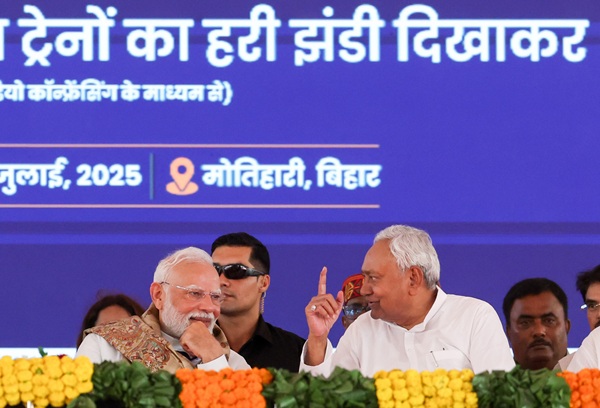.png)
Amitabh Tiwari, formerly a corporate and investment banker, now follows his passion for politics and elections, startups and education. He is Founding Partner at VoteVibe.
November 6, 2025 at 3:16 AM IST
As dawn breaks over the Ganga plains, a familiar rhythm returns to Bihar. The loudspeakers fall silent, the campaign dust settles, and the real voices of democracy prepare to speak. Today, voters across 121 constituencies in 18 districts step out to decide who will shape the state’s next government — the first act in a two-phase election that will test alliances, loyalties, and the pulse of the people.
As Bihar heads into the first phase of its 2025 Assembly elections, the field is crowded with familiar giants and bold newcomers.
The NDA enters the contest with the JD(U) fielding 57 candidates, the BJP contesting 48, while the Lok Janshakti Party (Ram Vilas) fields 13 and the Rashtriya Lok Morcha two, respectively.
Across the aisle, the Grand Alliance — Mahagathbandhan — stakes its claim with the RJD leading on 71 seats, followed by the Congress with 24, and the Left parties on 14.
Smaller outfits are also in the fray — the Vikassheel Insaan Party (VIP) and CPI contest six seats each, CPI(M) three, and the Indian Inclusive Party two.
But the real wildcard is Prashant Kishor’s Jan Suraj Party, which has fielded an ambitious 118 candidates, signaling its intent to disrupt the state’s traditional two-front contest.
Battle Steeped in Memory
In 2020, the Mahagathbandhan won 61 seats, the NDA secured 59, and Others took one seat in these same constituencies.
Five years ago, these constituencies wrote a gripping chapter in Bihar’s political story. The Rashtriya Janata Dal dominated this region, winning 42 seats out of 121. The Bharatiya Janata Party followed with 32, while JD(U) managed 23. The Congress took eight, and the Left parties bagged 11.
In 2020, the LJP weakened JD(U)’s prospects in 21 constituencies, pushing it to second or third place. The NDA now hopes these seats will swing its way in 2025, giving it a strong lead ahead of Phase 2 on November 11.
That past looms large today. For the RJD-led Mahagathbandhan, it’s a test of endurance — can they hold the red heartlands they captured last time? For the NDA, led by the BJP and JD(U), it’s about reclaiming lost ground and re-establishing their network of trust. Every seat here carries the echo of 2020’s verdict, and every voter holds the power to rewrite it.
New Faces, Old Equations
The NDA and MGB have each introduced 17 new candidates, hoping to channel local energy and appeal to first-time voters. At the same time, both have shown restraint — fielding 43 sitting MLAs each, trusting familiar faces who’ve delivered in the past.
The NDA has gone a step further by inducting three sitting MLAs from rival parties, while the MGB has embraced one such crossover — tactical moves aimed at expanding influence in tight corners. It’s a quiet reminder that in Bihar’s politics, loyalty often follows opportunity.
Despite elaborate seat-sharing arrangements, harmony within alliances remains fragile.
In six constituencies, “friendly contests” have emerged:
- Congress faces RJD in one seat
- Congress locks horns with CPI in three
- Congress and IIP clash in one
- RJD and VIP face off in another
No Bihar election is complete without the drama of rebellion. This year, 17 rebel candidates have entered the fray: six from RJD, one from Congress, seven from JD(U), and three from the BJP. This means seven rebels from the MGB and 10 from the NDA — each capable of derailing official candidates in closely contested seats.
In many localities, these rebels aren’t fringe players — they are community leaders, ex-MLAs, or influential sarpanches commanding personal loyalty that can tilt a few thousand votes either way.
On 56 of the 121 seats, the same social group candidate has been winning for the past three elections. The NDA has put up 38 and the MGB 18 candidates from the same communities. The JSP is hoping to damage both by fielding 48 upper-caste and 17 MY (Muslim-Yadav) candidates.
Ten High-Stakes Contests
Raghopur (Vaishali): The Heir’s Fortress
All eyes are on Tejashwi Yadav, who defends his family’s bastion against BJP’s Satish Kumar Yadav and a third-front challenger. Raghopur isn’t just another constituency — it’s the emotional epicentre of RJD politics and a referendum on the Yadav legacy.
Tarapur (Munger): The Deputy CM’s Test
Deputy Chief Minister Samrat Choudhary faces RJD’s Arun Kumar in a prestige battle that could redefine the NDA’s leadership narrative. For the BJP, Tarapur is more than a seat — it’s a symbol of authority and continuity.
Mahua (Vaishali): Brothers, Ballots, and Betrayal
The Mahua contest has turned into a family drama, with Tej Pratap Yadav running as an independent against his former party, the RJD, and a BJP contender. The triangular fight could split the Yadav vote — and test Tej Pratap’s personal clout on his home turf.
Lakhisarai (Munger): Sinha vs the Sentiment
Speaker Vijay Kumar Sinha seeks to hold ground against Congress’s Amresh Kumar. The seat, steeped in upper-caste dynamics, is crucial for the BJP’s narrative of stability and governance amid rising anti-incumbency whispers.
Alinagar (Darbhanga): Melody Meets Mandate
Singer-turned-politician Maithili Thakur makes her political debut from Alinagar, taking on RJD veteran Vinod Mishra. The contest is being watched as a test of celebrity influence versus traditional cadre strength in the heart of Mithilanchal.
Ministers on the Line
The first phase of polling in Bihar isn’t just a test for alliances — it’s a trial by fire for Chief Minister Nitish Kumar’s cabinet, with the fate of 16 ministers hanging in the balance. Among them, 11 belong to the BJP and five to the JD(U), making this phase crucial for both parties’ internal equations and public standing.
For the BJP, several prominent names are in the fray — Mangal Pandey from Siwan, Nitin Naveen from Bankipur, Samrat Choudhary from Tarapur, Vijay Kumar Sinha from Lakhisarai, Jivesh Mishra from Jale, Sanjay Saraogi from Darbhanga Urban, and Sunil Kumar from Bihar Sharif. Each carries both the weight of governance and the challenge of local anti-incumbency.
On the JD(U) side, the stakes are equally high. Senior ministers like Vijay Kumar Chaudhary (Sarai Ranjan), Shravan Kumar (Nalanda), Madan Sahni (Bahadurpur), and Maheshwar Hazari (Kalyanpur) are battling to defend Nitish Kumar’s legacy at the grassroots.
The outcome of this phase will serve as a litmus test for Chief Minister Nitish Kumar’s governance record, Deputy CM Samrat Choudhary’s leadership, and Tejashwi Yadav’s mass connect. With the second phase just days away, the momentum from these 121 seats could well define the narrative — whether Bihar votes for continuity, change, or a new alternative altogether.




